WL2H-U Module Datasheet
Last Updated on : 2025-11-13 10:03:48download
WL2H-U is a low-power embedded Wi-Fi module developed by Tuya. It consists of a highly integrated RF chip (LN882H) and several peripheral circuits and supports STA/AP/STA+AP modes and Bluetooth Low Energy (LE) connection.
Overview
WL2H-U is embedded with a 32-bit microcontroller unit (MCU) that can operate at a frequency of up to 160 MHz, 128 KB read-only memory (ROM), and 296 KB random-access memory (RAM). This enables the module to connect to Tuya Cloud. In addition, extended instructions of the MCU for signal processing enable the module to encode and decode audio data. The module contains extensive peripherals, such as pulse-width modulation (PWM), universal asynchronous receiver/transmitter (UART), and serial peripheral interface (SPI). The 32-bit PWM output enables the chip to be suitable for high-quality LED control of RGBCW lights.
Features
- Embedded low-power 32-bit MCU, functioning as an application processor
- Clock rate: 160 MHz
- Working voltage: 3.0V to 3.6V
- Peripherals: five PWMs, two UARTs, and one SPI
- Wi-Fi connectivity
- 802.11b/g/n
- Channels 1 to 14 at 2.4 GHz
- WEP, WPA/WPA2, WPA/WPA2 PSK (AES), and WPA3 security modes
- Up to +16 dBm output power in 802.11b mode
- STA/AP/STA+AP working modes
- EZ and AP pairing modes for Android and iOS devices
- Onboard PCB antenna, with up to 1.39 dBi antenna gain
- Working temperature: -40°C to +105°C
- Bluetooth connectivity
- 7 dBm transmitting power
- Complete Bluetooth coexistence interface
- Onboard PCB antenna, with up to 1.39 dBi antenna gain
Applications
- Smart building
- Smart home and smart appliances
- Smart socket and light
- Industrial wireless control
- Baby monitor
- IP camera
- Smart public transportation
Change history
| Date | Change Description | Document Version |
|---|---|---|
| 2022-6-16 | This is the first release. | V1.0.0 |
Module interfaces
Dimensions and packaging
WL2H-U dimensions: 15.8±0.35 mm (W) × 20.3±0.35 mm (L) × 2.7±0.15 mm (H) The following figure shows the overall layout of WL2H-U.
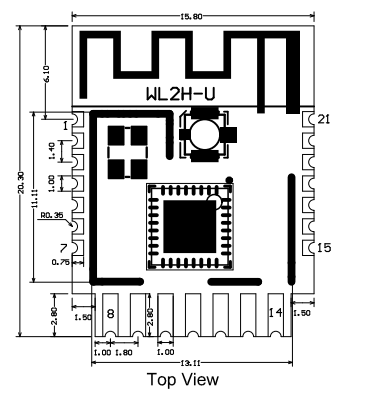
Pin definition
| Pin No. | Symbol | I/O Type | Description |
|---|---|---|---|
| 1 | GPIOA5 | I/O | Common GPIO pin, which can be reused as SPI_SCK and corresponds to pin 13 of the IC. |
| 2 | GPIOA6 | I/O | Common GPIO pin, which can be reused as SPI_MOSI and corresponds to pin 14 of the IC. |
| 3 | GPIOA4 | I/O | Common GPIO pin, corresponding to pin 12 of the IC. |
| 4 | GPIOA1 | I/O | Common GPIO pin, corresponding to pin 9 of the IC. |
| 5 | ADC | I/O | ADC pin, corresponding to the GPIOA0 pin (pin 8) of the IC. |
| 6 | RX1 | I/O | UART_RX1 pin, corresponding to the GPIOB8 pin (pin 29) of the IC. |
| 7 | TX1 | I/O | UART_TX1 pin for log printing, corresponding to the GPIOB9 pin (pin 30) of the IC. |
| 8 | GPIOA7 | I/O | PWM pin, corresponding to pin 15 of the IC. |
| 9 | GPIOA10 | I/O | PWM pin, corresponding to pin 21 of the IC. |
| 10 | GPIOA11 | I/O | PWM pin, corresponding to pin 22 of the IC. |
| 11 | GPIOA12 | I/O | PWM pin, corresponding to pin 23 of the IC. |
| 12 | GPIOB3 | I/O | PWM pin, corresponding to pin 24 of the IC. |
| 13 | GND | P | The ground wire. |
| 14 | 3V3 | P | 3.3V power supply. |
| 15 | TX0 | I/O | UART_TX0 pin for sending user data, corresponding to the GPIOA2 pin (pin 10) of the IC. |
| 16 | RX0 | I/O | UART_RX0 pin for receiving user data, corresponding to the GPIOA3 pin (pin 11) of the IC. |
| 17 | GPIOB4 | I/O | Common GPIO pin, which can be reused as ADC2 and corresponds to pin 24 of the IC. |
| 18 | RST | I/O | Reset pin, which is active at a low level, internally pulled up, and compatible with other module designs. |
| 19 | GPIOB5 | I/O | Common GPIO pin, corresponding to pin 26 of the IC. |
| 20 | GPIOB6 | I/O | Common GPIO pin, which can be reused as SPI_MISO and corresponds to pin 27 of the IC. |
| 21 | GPIOB7 | I/O | Common GPIO pin, which can be reused as SPI_CS and corresponds to pin 28 of the IC. |
| Top side test point (burning pin) | GPIOA9 | I/O | Mode selection pin, which is pulled down before power-on to enter the burning mode and corresponds to pin 17 of the IC. |
Note: P indicates power-supply pins, and I/O indicates input/output pins.
Electrical parameters
Absolute electrical parameters
| Parameter | Description | Minimum Value | Maximum Value | Unit |
|---|---|---|---|---|
| Ts | Storage temperature | -55 | 125 | °C |
| VBAT | Power supply voltage | -0.3 | 3.9 | V |
| Electrostatic discharge voltage (human body model) | TAMB-25°C | -4 | 4 | kV |
| Electrostatic discharge voltage (machine model) | TAMB-25°C | -200 | 200 | V |
Normal working conditions
| Parameter | Description | Minimum Value | Typical Value | Maximum Value | Unit |
|---|---|---|---|---|---|
| Ta | Working temperature | -40 | - | 105 | °C |
| VBAT | Power supply voltage | 3 | 3.3 | 3.6 | V |
| VOL | I/O low-level output | VSS | - | VSS + 0.3 | V |
| VOH | I/O high-level output | VBAT - 0.3 | - | VBAT | V |
| Imax | I/O drive current | - | 6 | 20 | mA |
RF power consumption
| Working Status | Mode | Rate | TX Power/Receiving | Average Value | Peak Value (Typical Value) | Unit |
|---|---|---|---|---|---|---|
| Transmitting | 11b | 11 Mbps | +16 dBm | 297 | 375 | mA |
| Transmitting | 11g | 54 Mbps | +14 dBm | 242 | 355 | mA |
| Transmitting | 11n | MCS7 | +13.5 dBm | 236 | 353 | mA |
| Receiving | 11b | 11 Mbps | Constant receiving | 78 | 90 | mA |
| Receiving | 11g | 54 Mbps | Constant receiving | 78 | 90 | mA |
| Receiving | 11n | MCS7 | Constant receiving | 78 | 90 | mA |
Working current
| Working Mode | Working Status (Ta = 25°C) | Average Value | Maximum Value (Typical Value) | Unit |
|---|---|---|---|---|
| Bluetooth pairing | The module is in Bluetooth pairing mode, and the Wi-Fi indicator blinks quickly. | 88 | 288 | mA |
| AP pairing | The module is in AP mode, and the Wi-Fi indicator blinks slowly. | 105 | 370 | mA |
| EZ pairing | The module is in EZ mode, and the Wi-Fi indicator blinks quickly. | 92 | 354 | mA |
| Connected | The module is connected to the network, and the Wi-Fi indicator is steady on. | 93 | 222 | mA |
| Weakly connected | The module is weakly connected to the network, and the Wi-Fi indicator is steady on. | 100 | 373 | mA |
| Disconnected | The module is disconnected from the network, and the Wi-Fi indicator is steady off. | 96 | 388 | mA |
RF parameters
Basic RF features
| Parameter | Description |
|---|---|
| Frequency band | 2.412 GHz to 2.484 GHz |
| Wi-Fi standard | IEEE 802.11b/g/n (channels 1 to 14) |
| Data transmission rate | 11b: 1, 2, 5.5, 11 (Mbit/s) 11g: 6, 9, 12, 18, 24, 36, 48, 54 (Mbit/s) 11n: HT20 MCS0 to MCS7 |
| Antenna type | PCB antenna, with an antenna gain of 1.39 dBi |
Wi-Fi TX performance
| Parameter | Minimum Value | Typical Value | Maximum Value | Unit |
|---|---|---|---|---|
| Average RF output power, 802.11b CCK mode, 11 Mbit/s | - | 16 | - | dBm |
| Average RF output power, 802.11b OFDM mode, 54 Mbit/s | - | 14 | - | dBm |
| Average RF output power, 802.11n OFDM mode, MCS7 (HT20) | - | 13.5 | - | dBm |
| Frequency error | -20 | - | 20 | ppm |
Wi-Fi RX performance
| Parameter | Minimum Value | Typical Value | Maximum Value | Unit |
|---|---|---|---|---|
| PER < 8%, RX sensitivity, 802.11b DSSS mode, 11 Mbit/s | - | -88 | - | dBm |
| PER < 10%, RX sensitivity, 802.11g OFDM Mode, 54 Mbit/s | - | -74 | - | dBm |
| PER < 10%, RX sensitivity, 802.11n OFDM Mode, MCS7 (HT20) | - | -72 | - | dBm |
| PER < 10%, RX sensitivity, Bluetooth, 1 Mbit/s | - | -90 | - | dBm |
Bluetooth TX performance
| Parameter | Minimum Value | Typical Value | Maximum Value | Unit |
|---|---|---|---|---|
| Frequency band | 2402 | - | 2480 | MHz |
| Air rate | - | 1 | - | Mbit/s |
| Transmitting power | -20 | 7 | 20 | dBm |
| Frequency error | -150 | - | 150 | kHz |
Bluetooth RX performance
| Parameter | Minimum Value | Typical Value | Maximum Value | Unit |
|---|---|---|---|---|
| RX sensitivity | - | -90 | - | dBm |
| Maximum RF signal input | -10 | - | - | dBm |
| Inter-modulation | - | - | -23 | dBm |
| Co-channel interference suppression | - | 10 | - | dB |
Antenna information
Antenna type
WL2H-U uses an onboard PCB antenna, with an antenna gain of 1.39 dBi.
Antenna interference reduction
To ensure optimal Wi-Fi performance when the module uses an onboard PCB antenna, we recommended that the antenna be at least 15 mm away from other metal parts. To prevent adverse impact on the antenna performance, do not use copper or route cables along the antenna area on the PCB.
Packaging information and production instructions
Mechanical dimensions
PCB dimensions: 15.8±0.35 mm (W) × 20.3±0.35 mm (L) × 1.0±0.1 mm (H)
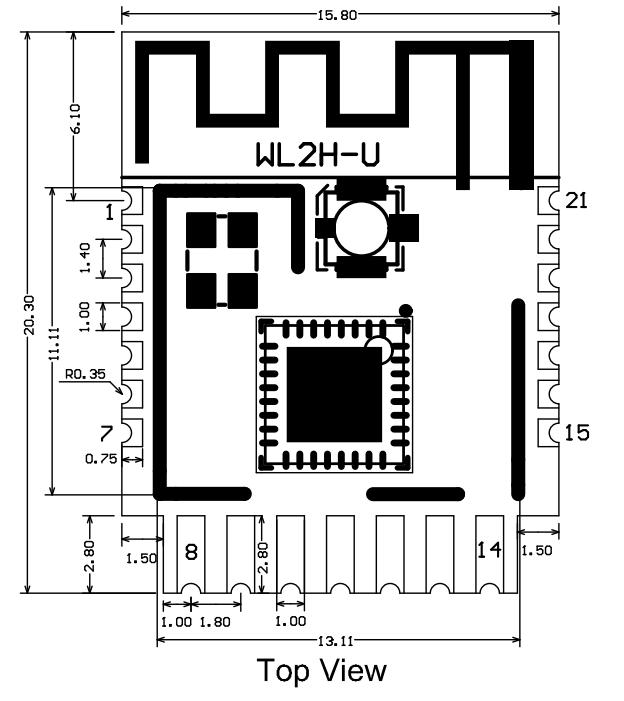
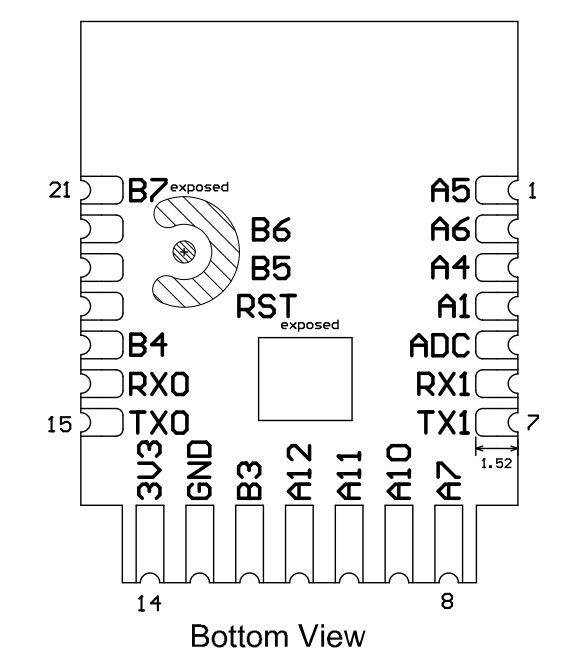

Recommended package
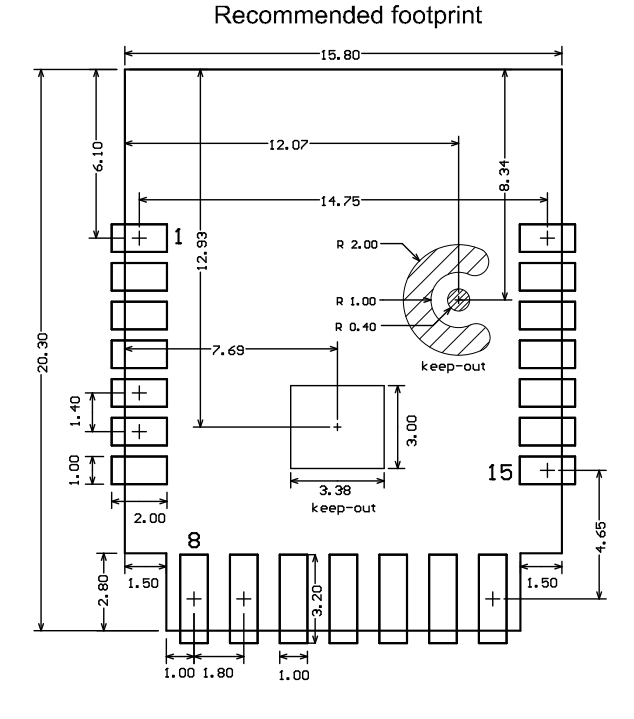
Production instructions
- For the modules that can be packaged with the surface-mount technology (SMT) or in in-line form, you can select either of them according to the PCB design solutions of customers. If a PCB is designed to be SMT-packaged, package the module with the SMT. If a PCB is designed to use an in-line package, use wave soldering. After being unpacked, the module must be soldered within 24 hours. Otherwise, it needs to be put into a drying cupboard where the relative humidity is not greater than 10% or packaged under vacuum again with the exposure time recorded. The total exposure time cannot exceed 168 hours.
- Devices required for the SMT process:
- Mounter
- SPI
- Reflow soldering machine
- Thermal profiler
- Automated optical inspection (AOI) equipment
- Devices required for the wave soldering process:
- Wave soldering machine
- Wave soldering fixture
- Constant-temperature soldering iron
- Tin bar, tin wire, and flux
- Thermal profiler
- Devices required for baking:
- Cabinet oven
- Anti-electrostatic and heat-resistant trays
- Anti-electrostatic and heat-resistant gloves
- Devices required for the SMT process:
- Storage conditions for a delivered module:
-
The moisture-proof bag must be placed in an environment where the temperature is below 40°C and the relative humidity is lower than 90%.
-
The shelf life of a dry-packaged product is 12 months from the date when the product is packaged and sealed.
-
There is a humidity indicator card (HIC) in the packaging bag.
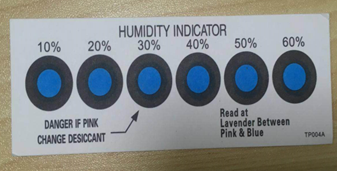
-
- The module needs to be baked in the following cases:
- The packaging bag is damaged before unpacking.
- There is no HIC in the packaging bag.
- After unpacking, circles of 10% and above on the HIC become pink.
- The total exposure time has lasted for over 168 hours since unpacking.
- More than 12 months have passed since the first sealing of the bag.
- Baking settings:
- Temperature: 60°C and ≤ 5% RH for reel package and 125°C and ≤ 5% RH for tray package (please use the heat-resistant tray rather than a plastic container)
- Time: 48 hours for reel package and 12 hours for tray package
- Alarm temperature: 65°C for reel package and 135°C for tray package
- Production-ready temperature after natural cooling: < 36°C
- Re-baking situation: If a module remains unused for over 168 hours after being baked, it needs to be baked again.
- If a batch of modules is not baked within 168 hours, do not use the reflow soldering or wave soldering to solder them. Because these modules are Level-3 moisture-sensitive devices, they are very likely to get damp when exposed beyond the allowable time. In this case, if they are soldered at high temperatures, it may result in device failure or poor soldering.
- In the whole production process, take electrostatic discharge (ESD) protective measures.
- To guarantee the passing rate, we recommended that you use the SPI and AOI to monitor the quality of solder paste printing and mounting.
Recommended oven temperature curve
Select a proper soldering technique according to the process. For the SMT process, see the recommended oven temperature curve of reflow soldering. For the wave soldering process, see the recommended oven temperature curve of wave soldering. There are some differences between the set temperatures and the actual temperature measurements. All the temperatures shown in this module datasheet are obtained through actual measurements.
Technique 1: SMT process (Recommended oven temperature curve of reflow soldering)
Set the oven temperatures according to the following curve.
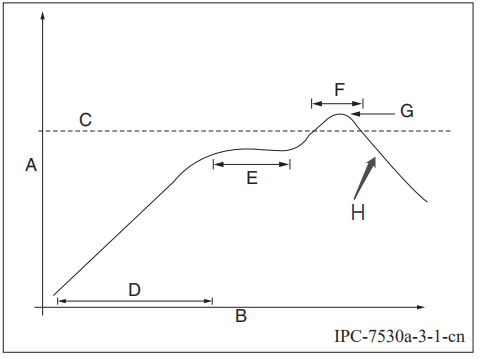
-
A: Temperature axis
-
B: Time axis
-
C: Liquidus temperature: 217°C to 220°C
-
D: Ramp-up slope: 1°C/s to 3°C/s
-
E: Duration of constant temperature: 60s to 120s. The range of constant temperature: 150°C to 200°C
-
F: Duration above the liquidus: 50s to 70s
-
G: Peak temperature: 235°C to 245°C
-
H: Ramp-down slope: 1°C/s to 4°C/s
Note: The above curve is just an example of the solder paste SAC305. For more information about other solder pastes, see the recommended oven temperature curve in the solder paste specifications.
Technique 2: Wave soldering process (Oven temperature curve of wave soldering)
Set the oven temperatures according to the following temperature curve of wave soldering. The peak temperature is 260°C±5°C.
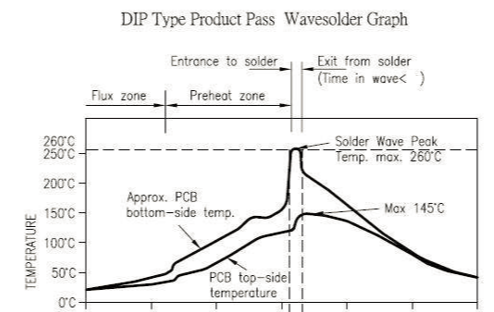
| Suggestions on Oven Temperature Curve of Wave Soldering | Suggestions on Manual Soldering Temperature | ||
|---|---|---|---|
| Preheat temperature | 80°C to 130°C | Soldering temperature | 360°C±20°C |
| Preheat time | 75s to 100s | Soldering time | < 3s/point |
| Peak contact time | 3s to 5s | - | - |
| Temperature of tin cylinder | 260°C±5°C | - | - |
| Ramp-up slope | ≤ 2°C/s | - | - |
| Ramp-down slope | ≤ 6℃/s | - | - |
Storage conditions
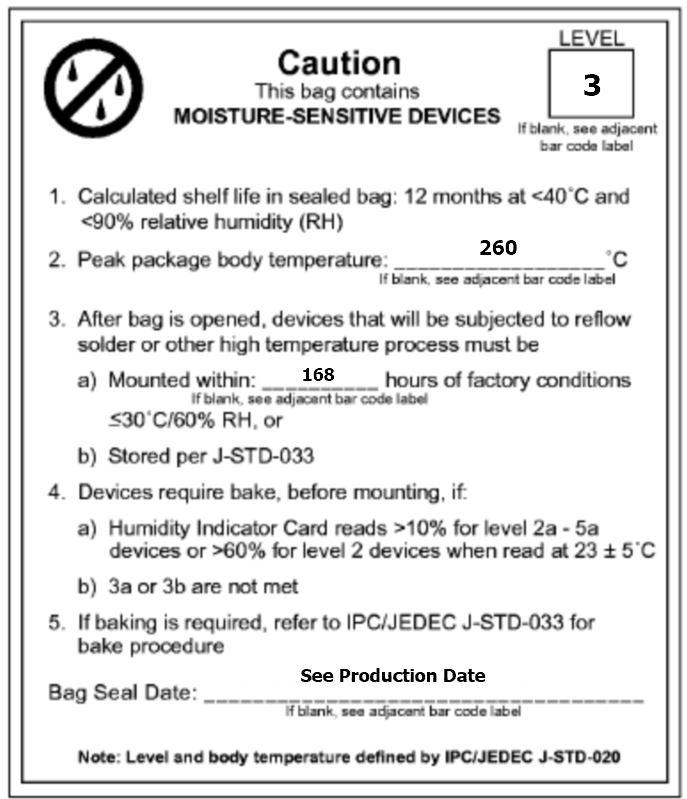
MOQ and packaging information
| Product model | MOQ (pcs) | Shipping Packaging Method | Number of Modules per Reel | Number of Reels per Carton |
|---|---|---|---|---|
| WL2H-U | 4400 | Tape reel | 1100 | 4 |
Appendix: Declaration
FCC Caution: Any changes or modifications not expressly approved by the party responsible for compliance could void the user’s authority to operate this device.
This device complies with Part 15 of the FCC Rules. Operation is subject to the following two conditions: (1) This device may not cause harmful interference, and (2) this device must accept any interference received, including interference that may cause undesired operation.
Note: This device has been tested and found to comply with the limits for a Class B digital device, according to part 15 of the FCC Rules. These limits are designed to provide reasonable protection against harmful interference in a residential installation. This device generates, uses, and can radiate radio frequency energy and, if not installed and used following the instructions, may cause harmful interference to radio communications. However, there is no guarantee that interference will not occur in a particular installation.
If this device does cause harmful interference to radio or television reception, which can be determined by turning the device off and on, the user is encouraged to try to correct the interference by one or more of the following measures:
- Reorient or relocate the receiving antenna.
- Increase the separation between the device and receiver.
- Connect the device into an outlet on a circuit different from that to which the receiver is connected.
- Consult the dealer or an experienced radio/TV technician for help.
Radiation Exposure Statement
This device complies with FCC radiation exposure limits set forth for an uncontrolled rolled environment. This device should be installed and operated with a minimum distance of 20cm between the radiator and your body.
Important Note
This radio module must not be installed to co-locate and operating simultaneously with other radios in the host system except following FCC multi-transmitter product procedures. Additional testing and device authorization may be required to operate simultaneously with other radios.
The availability of some specific channels and/or operational frequency bands are country dependent and are firmware programmed at the factory to match the intended destination. The firmware setting is not accessible by the end-user.
The host product manufacturer is responsible for compliance with any other FCC rules that apply to the host not covered by the modular transmitter grant of certification. The final host product still requires Part 15 Subpart B compliance testing with the modular transmitter installed.
The end-user manual shall include all required regulatory information/warnings as shown in this manual, including “This product must be installed and operated with a minimum distance of 20 cm between the radiator and user body”.
This device has got an FCC ID: 2ANDL-WL2H-U. The end product must be labeled in a visible area with the following: “Contains Transmitter Module FCC ID: 2ANDL-WL2H-U”.
This device is intended only for OEM integrators under the following conditions:
The antenna must be installed such that 20cm is maintained between the antenna and users, and the transmitter module may not be co-located with any other transmitter or antenna.
As long as the 2 conditions above are met, further transmitter tests will not be required. However, the OEM integrator is still responsible for testing their end-product for any additional compliance requirements required with this module installed.
Declaration of Conformity European Notice

Hereby, Hangzhou Tuya Information Technology Co., Ltd declares that this module product is in compliance with essential requirements and other relevant provisions of Directive 2014/53/EU,2011/65/EU. A copy of the Declaration of conformity can be found at https://www.tuya.com.

This product must not be disposed of as normal household waste, in accordance with the EU directive for waste electrical and electronic equipment (WEEE-2012/19/EU). Instead, it should be disposed of by returning it to the point of sale, or to a municipal recycling collection point.
The device could be used with a separation distance of 20cm to the human body.
Is this page helpful?
YesFeedbackIs this page helpful?
YesFeedback





